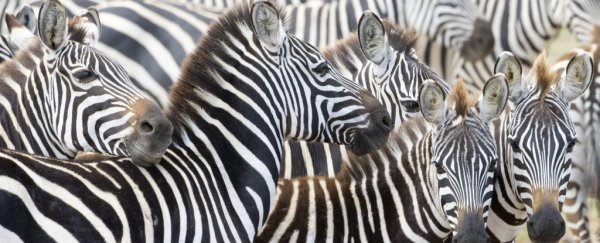Zebra stripes do not help regulate their body temperature. That's the conclusion reached by researchers in Hungary, trying to narrow down a longstanding mystery about the animals' amazing coats.
Zebras are magnificent animals, with the tall stature and long faces shared with their horse family (equid) cousins. Unlike equids, though, they're dazzlingly striped black and white.
It's a colouration that must have evolved for a reason, yet scientists have struggled to figure it out.
One of the prevailing hypotheses has been that they help zebras stay cool, a notion supported by the recent finding that zebras in warmer climates have more stripes covering their entire bodies compared to zebras in cooler regions.
The idea is that because black and white absorb and reflect heat differently, the air around the stripes moves at different rates. This, theoretically, would create tiny convection currents at the boundaries between the stripes that would serve to cool the zebra down.
Pretty intriguing, right?
To test if this effect actually works, a team of researchers led by Gábor Horváth of the Eötvös Loránd University in Hungary used an interesting method: barrels of water, covered in animal skins.
"A zebra body was modelled by water-filled metal barrels covered with horse, cattle and zebra hides and with various black, white, grey and striped patterns," they wrote in their paper.
"The barrels were installed in the open air for four months while their core temperature was measured continuously. Using thermography, the temperature distributions of the barrel surfaces were compared to those of living zebras."
 (Horváth et al./Scientific Reports)
(Horváth et al./Scientific Reports)
The sunlit zebra-striped barrels reproduced the surface temperature characteristics of actual sunlit zebras really well, which meant the team had a strong analog on their hands.
But when the researchers compared the core temperature of the barrel between the different skins, even on runs of very hot days, the zebra barrel did not significantly differ from the grey barrel.
So, it looks like stripes did not provide a thermoregulation advantage over solid grey colouration.
"The average core temperature of the barrels increased as follows: white cattle, grey cattle, real zebra, artificial zebra, grey horse, black cattle," the researchers wrote.
As to solving the mystery of what the stripes are really for, it's back to the drawing board.
Thankfully, previous research has already ruled out two other big contenders, camouflage and social interaction - so we're getting closer with every step.
Two other major hypotheses remain. The first is the idea that the stripes produce a sort of optical illusion that "dazzles" predators when the zebras are running. It's possible, but the jury is still out on that one.
The other is that the stripes deter biting, bloodsucking flies. This may have something to do with polarisation. A 2012 study (in which Horváth also participated) found that the light and dark stripes reflect polarised light in a way that deters flying insects; put more simply, flies don't like landing on zebras' striped coats.
And this would neatly explain the higher number of stripes in warmer climates, too. The type of flies that are of biggest annoyance to zebras also prefer warmer temperatures.
Still, there may be multiple reasons for the stripes. We may not know for sure until they've all been roundly and thoroughly field-tested.
The team's research has been published in the journal Scientific Reports.
